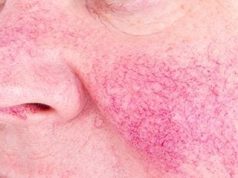Diffuse, persistent, pruritic maculopapular rash developed 10 days after tocilizumab treatment
WEDNESDAY, May 31, 2017 (HealthDay News) — In a case report published online May 23 in the Annals of Internal Medicine, a severe adverse cutaneous reaction to tocilizumab in a 55-year-old patient is described.
Elina Zuelgaray, M.D., from the Assistance Publique-Hôpitaux de Paris, and colleagues present a case of severe adverse cutaneous effects from tocilizumab in a 55-year-old woman. The patient was hospitalized for a two-month history of spiking fevers, sore throat, arthralgia, evanescent maculopapular rash, leukocytosis, elevated C-reactive protein and ferritin, and reduced levels of glycosylated ferritin. Diagnosis of adult-onset Still disease was made, treated with tocilizumab monotherapy after oral corticosteroids and methotrexate failed.
The patient developed an unusual diffuse, persistent, pruritic maculopapular rash 10 days after the first tocilizumab administration. The rash improved with topical corticosteroids, but hypereosinophilia was seen on laboratory tests 10 days later, along with elevated liver enzyme levels. Five weeks after discontinuing tocilizumab therapy, the new manifestations attributed to this syndrome resolved.
“There are few standards for diagnosis of drug reaction with eosinophilia and systemic symptoms syndrome, which relies on a compatible history and typical clinical manifestations and laboratory results in the absence of other possible conditions,” the authors write.
Abstract/Full Text (subscription or payment may be required)
Copyright © 2017 HealthDay. All rights reserved.








